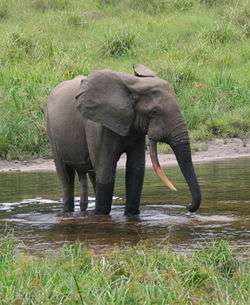Ivindo National Park
| Ivindo National Park | |
|---|---|
|
IUCN category II (national park) | |
| Location | Gabon |
| Nearest city | Makokou |
| Coordinates | 0°05′17″N 12°37′48″E / 0.088°N 12.63°E[1]Coordinates: 0°05′17″N 12°37′48″E / 0.088°N 12.63°E[2] |
| Area | 3,000 square kilometres (1,200 sq mi) |
| Established | 2002 |
| Governing body | National Agency for National Parks |
Ivindo National Park is a national park in east-central Gabon in Central Africa, straddling the border of the Ogooué-Ivindo and Ogooué-Lolo provences. Its creation was announced in August 2002 by then-President Omar Bongo at the Earth Summit in Johannesburg, along with Gabon’s 12 other terrestrial national parks. Most famous for the spectacular Kongou and Mingouli waterfalls of the Ivindo River, known as the “wonders of Ivindo”,[3] the park also includes the Ipassa Makokou Biosphere Reserve and Langoué Baï, one of the 5 most important forest clearings in Central Africa.[4] The Institut de Recherche en Écologie Tropicale (IRET), a tropical research institute under the authority of the Centre national de la recherche scientifique et technologique (CENAREST), is found in the north of the park, 12 km from the closest city, Makokou,[5] while Langoué Research Station, run by the Wildlife Conservation Society (WCS) is found in the south a few kilometers from Langoué Baï.
Physical features of the park include the Ivindo River, the park is the main tributary to the Ogooué, and Mount Kingué (749 m)[6] and Mount Ngouadi (870 m). Average rainfall is 1672 mm, with peaks in rainfall between September and December, and February and May.[3] Violent thunderstorms occur seasonally, and can sometimes generate localised tornadoes, especially on the Ipassa Plateau; the disturbances caused by this effect may be responsible for the fact that this forest superficially resembles secondary forest.[3] Average temperature is 23.9 °C (measured at Makokou a few kilometres from the northern park border), with seasonal variation of around 3.3 °C.[3]
The park covers 300,000 ha, almost all of which is forested with a mixture of Atlantic coastal forest of Lower Guinea, and semi-deciduous forest typical of central Congo Basin. Wildlife includes western lowland gorilla, common chimpanzee, African forest buffalo, red river hog, sitatunga, as well as one of the last relativity intact populations of forest elephants.[3] Notable bird species include grey-necked rockfowl, while more than 430 bird species have been recorded within the park.[6]
Since 2001, before the park's creation, the WCS has studied and protected the southern region of the park, concentrated at Langoué Bai, with the support of what is now the Gabonese National Parks Agency (ANPN). In 2004 WCS constructed a purpose-built camp 3 km from Langoué Bai, with accommodation and offices for researchers, providing important insights into bai ecology and a protective presence against poachers.[7]
|
References
- ↑ Ivindo National Park protectedplanet.net
- ↑ Ivindo National Park protectedplanet.net
- 1 2 3 4 5 Vande weghe, Jean Pierre (2009). Ivindo and Mwanga. WCS. p. 7. ISBN 978-0-9820263-2-8.
- ↑ "Gabonese Republic". Retrieved 2013-10-20.
- ↑ "Institut de Recherche en Ecologie Tropicale". Retrieved 2015-01-06.
- 1 2 Hickendorff, Annelies. Gabon. Bradt Travel Guides. ISBN 9781841625546.
- ↑ "Ivindo National Park, Gabon - WCS". WCS. Wildlife Conservation Society. Retrieved January 2015. Check date values in:
|access-date=(help)
External links
| Wikimedia Commons has media related to Ivindo National Park. |
- Fondation Internationale Gabon Ecotourisme (FIGET), International Foundation of Gabonese Ecotourisme
- Wildlife Conservation Society
- Ivindo National Park - National Park Agency
- Virtual Tour of the National Parks
- Institut de Recherche en Ecologie Tropicale (IRET)
- Research stations in Gabon's parks, including Ipassa and Langoué Bai
